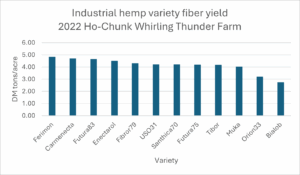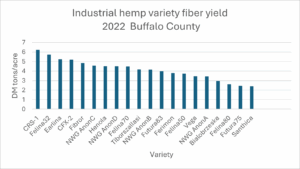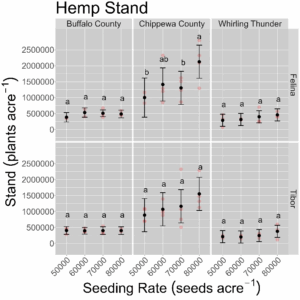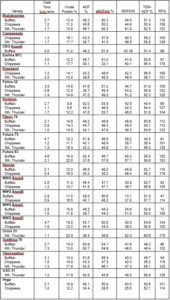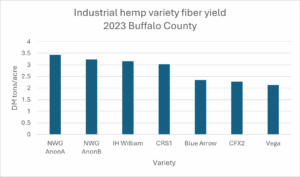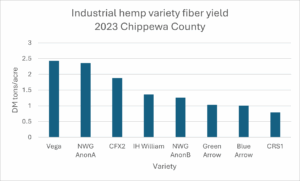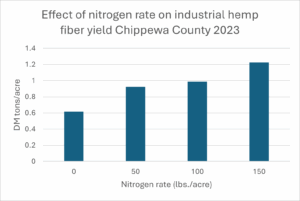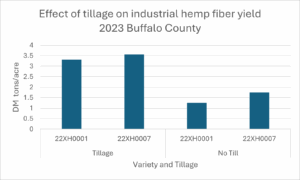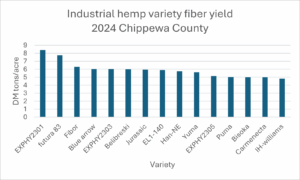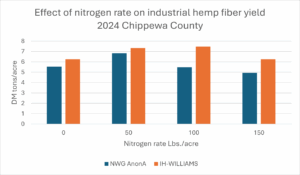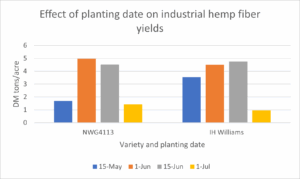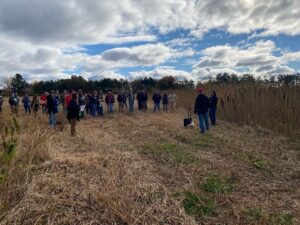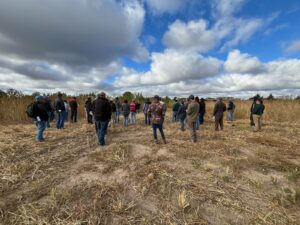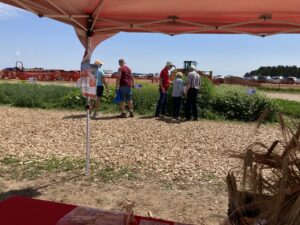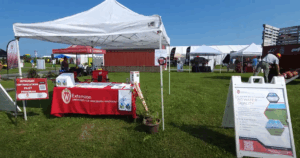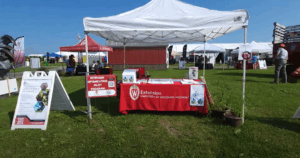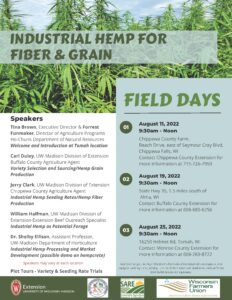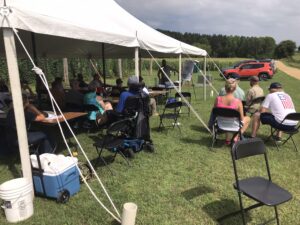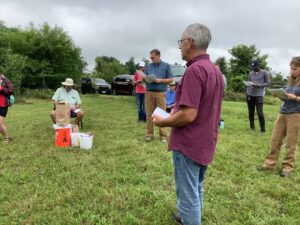Final report for ONC22-098
Project Information
Western Wisconsin has moved from a major forage producing region to a continuous row crop producing region, mainly a corn/soybean rotation. Adding a new environmentally friendly and economically viable crop such as industrial hemp to the traditional corn-soybean rotation improves the sustainability of our soil and water resources. Industrial Hemp research and educational programming was conducted in 2022-2024 through partnerships with farms in Chippewa and Buffalo counties and with the Ho-Chunk Nation located near Monroe County. Research and education of industrial hemp for grain and fiber helped determine if the crop could be incorporated into an existing conventional crop rotation.
Farmers and partners were interested in basic agronomic needs industrial hemp to help with production management decisions. Industrial hemp on-farm research trials focused nitrogen application rates, variety evaluation, and planting date to determine initial production yield and input benchmarks. On-farm research was conducted on three Western Wisconsin farms with three different soil types and three different production systems. Soil types and systems included a non-irrigated sandy soil with a conventional tillage system (Chippewa County), an eroded, productive silt loam ridgetop soil in a no-till system (Buffalo County), and highly productive loamy soil in an organic system (Ho-Chunk Nation). All plots were used a random block design with four replications. Different trials were held different years depending on partnership availability.
A new variable investigated in 2023 was planting date. Observations from 2019-2022 have shown a mid-June planting date for hemp has resulted in good stands and yields. Grain yield was also measured for the first time in 2023 across two of the locations. Variables measured in 2023 and 2024 included varieties, planting date, tillage systems, and nitrogen rate application. Data collected included biomass, fiber yield, grain yield, and forage quality. Farm partners have interest in fiber hemp as an emergency forage crop, which is common in parts of Europe and is currently not legal in the United States. Forage quality analysis was only measured through lab testing and not fed to any livestock or as part of any other research study.
Variety trial and forage quality analysis was conducted on the Ho-Chunk Nation Whirling Thunder Farm only in 2022 as changes in staff in 2023 limited research implementation and data collection. Variety trials occurred in Buffalo County in 2022 and 2023. Tillage trials were implemented in Buffalo County only in 2023. Variety trials, nitrogen application rate study, and planting date study were completed in Chippewa County from 2022-2024.
The major objectives of this project are listed below. Each of the ag professional partners will be responsible for specific objectives.
- Evaluate fiber and grain hemp varieties to determine performance in Wisconsin soils and growing conditions.
- Fiber and grain hemp varieties were evaluated at all three locations in 2022.
- Fiber and grain hemp varieties were evaluated at Buffalo and Chippewa County in 2023 and 2024
- Identify proper planting dates for fiber and grain to meet potential industry needs.
- Planting date trials were held in 2023 and 2024 at the Chippewa County location.
- Evaluate environmental impact (soil loss, soil nitrogen movement) of industrial hemp in crop rotations.
- Soil loss measurements were calculated using the Soil Nutrient Application Program (SNAP-Plus) software program.
- Soil loss measurements were used with a traditional corn-soybean-alfalfa crop rotation with industiral hemp added to the rotation.
- Conventional and no-till systems were used to evaluate fiber production in Buffalo County in 2023.
- Measure fiber hemp forage quality as a potential ruminant animal feedstuff (lab analysis only).
- Fiber hemp forage quality samples were taken in 2022 from select varieties at all three locations.
- Begin a fiber hemp cost of production database as a guide for Midwest farmers.
- A database was not initiated due to staff changes. A cost of production spreadsheet was developed to assist growers with basic input costs and revenue estimates.
- Evaluate nitrogen application rates and fiber yield.
- Nitrogen application rates were evaluated at the Chippewa County location in 2023 and 2024.
- Four nitrogen rates were used on one variety in 2023 and two varieties in 2024.
Cooperators
- (Educator)
Research
Adding an environmentally friendly and economically viable crop to the traditional corn-soybean rotation improves the sustainability of soil and water resources.
Research was located on three Western Wisconsin farms with three different soil types and production systems. Systems included a non-irrigated sandy soil with a conventional tillage system in Chippewa County, an eroded (but still productive) silt loam ridgetop soil in a no-till/limited tillage system in Buffalo County, and a highly productive loamy soil in an organic system using conventional tillage at the Ho-Chunk Nation. All plots were used a random block design and replicated four times to provide statistically reliable data. All locations used the same research design.
Variables measured included total biomass produced per acre, fiber yield based on variety and seeding dates, nitrogen fertilizer needs for the crop, and basic forage quality. Farm partners have an additional interest in fiber hemp as an emergency forage crop, which is common in parts of Europe. Finally, the project team will calculate rotation soil loss at each farm under traditional corn/soybean rotation and compare with rotations containing hemp and other possible rotation crops.
Fiber varieties evaluated varied each year depending on variety availability and included dual purpose (grain/fiber varieties). Variety trials and planting date studies had nitrogen applied at 100 lb./acre. The Whirling Thunder Farm at the Ho-Chunk Nation use organically certified nitrogen sources. The nitrogen rate study included rates of 0, 50, 100, and 150 lbs./acre in the form of SuperU encapsulated urea. These rates were hand-applied in a small plot design. Nitrogen was applied immediately following planting. The planting date study included four planting dates of mid-May, early June, mid-June and early July. Two varieties were used for all planting dates. A seeding rate study was conducted in 2022 at all three locations. Seeding rates for fiber evaluation were conducted on two varieties with rates of 50,000, 60,000, 70,000, and 80,000 seeds per acre.
A 3' x 4' random area was harvested for each variety, tillage, nitrogen rate, and planting date trial. Fresh material was weighed along with three stem diameter measurements. Fiber was retted for one month and dry weights were then taken to estimate dry matter.
Data for this report is presented by the year in which a specific trial was conducted. Trials varied by location as staff and resources changed over the three-year period.
2022 industrial hemp fiber yield by variety data is displayed in the charts below. Variety availability dictated where varieties were evaluated. All varieties were not evaluated at all locations. Precipitation, temperature, and soil type can influence performance of varieties. Twelve varieties were evaluated at the Ho-Chunk Whirling Thunder farm under organic growing conditions. Yields ranged from 4.84 to 2.75 tons of dry matter per acre. No crop protection products were used at this location.
In 2022, twenty fiber and dual purpose varieties were evaluated at the Buffalo County site. Yields ranged from 6.23 to 2.41 tons of dry matter per acre.
Eighteen fiber and dual purpose varieties were evaluated at the Chippewa County site. Yields ranged from 9.88 to 2.56 tons of dry matter per acre. The wide range of yield was attributed to variety phenotype and soil moisture limitations late summer on the Scott Lake sandy loam soil at this location.
A seeding rate study was conducted at all three locations in 2022. Four seeding rates on two varieties were 50K, 60K, 70K, and 80K seeds per acre. No statistical significant difference resulted in final stand at the Buffalo County or Ho-Chunk Nation sites. A statistical significant difference resulted at the Chippewa County site on the Felina variety.
Forage quality analysis was measured in late July 2022 on 20 varieties to determine industrial hemp as a potential livestock feed ingredient. The planting date was mid-June at all three locations. Average growing time was 8 weeks. Not all varieties were evaluated at each location. Varieties were harvested prior to or at flowering to attempt to capture the highest quality. No palatability tests were measured and no samples were fed to livestock to measure animal performance. Yield was measured by sampling a 3' x 4' area and adjusting for lab measured moisture. A 30-hour digestibility test was used to measure forage quality.
In 2023, variety fiber performance was evaluated at the Buffalo and Chippewa County sites. Seven varieties were evaluated in Buffalo County and eight varieties in Chippewa County. Dry soil conditions throughout the year at both locations kept yields lower. Yields in Buffalo County ranged from 3.43 to 2.13 tons of dry matter per acre.
Yields were slightly lower in Chippewa County on lighter Scott Lake sandy loam soil. Yields ranged from 2.43 to 0.79 tons dry matter per acre.
2023 was the first year of a two-year nitrogen (N) rate study. One variety was used for this study. Nitrogen rates applied were 0, 50, 100, and 150 lbs./acre in the form of SuperU encapsulated urea. The study revealed a consistent increase in fiber yield as nitrogen rates were increased. Yields were doubled from the 0 lbs. N rate to the 150 lbs. rate.
In 2023, the planting date study revealed lower fiber yields on later planting dates. Extremely dry soil conditions occurred during this planting period which may have influenced final yield. May planting dates resulted in higher yields for both varieties as adequate top soil moisture was present.
The effect of tillage on industrial hemp fiber yields was evaluated at the Buffalo County location in 2023 as the landscape at this location presents steep slopes of more than 12%. Fiber dry matter yields were higher in the tilled plots compared to the no-till plots. Soil conditions at planting may have contributed to the difference as planting depth was difficult to achieve due to very dry topsoil conditions.
An analysis using Wisconsin's SnapPlus Nutrient Management Software program was applied to the Buffalo County location to measure soil erosion impact with industrial hemp included in the rotation. A 4-year simulated rotation of corn-grain (30 inch rows), soybean-grain (15 inch rows), industrial hemp, and barley-grain was used to evaluate soil loss. The research location site has a tolerable soil loss of 3 tons/acre. The analysis was run by replacing hemp with another year of corn grain production. Having industrial hemp in the rotation decreased estimated soil loss by 0.6 ton per acre.
In 2024, the Chippewa County location in partnership with Tony Bowe of Triple T Farms was the only research site. Staff changes and availability of land at Whirling Thunder and Buffalo County limited research locations. 2024 was an excellent growing season as regular precipitation kept soil moisture adequate through most of the season. Dry conditions in September and October led to good harvest and retting conditions. Fifteen fiber varieties were evaluated in 2024 with yields ranging from 8.40 to 4.83 dry matter tons per acre.
The second year of the nitrogen rate application study was established in 2024. Application rates consisted of 0, 50, 100, and 150 lbs./acre of actual nitrogen as SuperU encapsulated urea. Two varieties were planted for the study in 2024. Both varieties performed well under the 0 lb. application rate yielding over 5 dry matter tons/acre. The 50 lb./acre rate yielded as high or higher than the 100 lb./acre rate. Unlike 2023, the 150 lb./acre rate produced lower yields compared to the other application rates. Residual nitrogen from the previous soybean crop as well as a dry winter may have provided higher soil-nitrate levels thus influencing yields on lower application rates.
| N Rate | NWG AnonA | IH-WILLIAMS |
| 0 | 5.532 | 6.25 |
| 50 | 6.82 | 7.33 |
| 100 | 5.47 | 7.46 |
| 150 | 4.94 | 6.24 |
In 2024, two varieties and four planting dates were part of the planting date study. Fiber hemp varieties were planted on May 15, June 1, June 15, and July 1. The June 1 and June 15 planting dates yielded higher with both varieties. Warmer soil temperatures and adequate soil moisture may have influenced yields.
Educational & Outreach Activities
Participation Summary:
In March 2024, a presentation was given to the Wisconsin Land and Water Association at their state conference. Forty-five conservation professionals attended the session. A post-session evaluation indicated n=8, all participants increased their knowledge of hemp fiber and grain production. All indicated they found the information useful and would use it in their work.
Wisconsin Farm Technology Days was held in Chippewa County in August 2024. An educational booth highlighting industrial hemp and other crops was part of the display area. An estimated 54,000 people
The Wisconsin Land and Water Association Fall Tech Tour was held in October 2024 and the industrial hemp research projects were part of the tour. Fifty-four conservation professionals learned about industrial hemp as a potential rotation and conservation crop. Discussion also focussed on industrial hemp as an important pollinator host.
Educational and Informational Articles and Podcasts were developed.
https://cropsandsoils.extension.wisc.edu/articles/the-cutting-edge-podcast-episode-35-a-ho-chunk-perspective-on-hemp/
https://cropsandsoils.extension.wisc.edu/articles/the-cutting-edge-podcast-episode-34-hemp-research-updates/
https://cropsandsoils.extension.wisc.edu/articles/the-cutting-edge-episode-26-uw-hemp-trials/
Educational Field Days
2024 Farm Technology Days Chippewa County
Three field days were held at the Chippewa Falls research location each year of the project. Updates were given on each objective of the project. April 20, 2023 we held a virtual field day reporting on this project and other hemp related projects in Wisconsin. A local FFA chapter helped with data gathering in 2023 and has taken an interest in industrial hemp relating to animal feed and animal bedding. Two Wisconsin state senators and assembly elected officials stopped at the field days to learn about hemp as a potential economic engine.
2023 Research Field Day July 19 Chippewa County Farm
2023 Emerging Crops Field Day August 3 Chippewa County Farm
2022 August - Whirling Thunder, Ho-Chunk Nation; Braager Farm, Buffalo County; Chippewa County Research Farm
2022 media outreach
Learning Outcomes
Farmers increase knowledge about industrial hemp as a conservation crop planting to save soil and as a potential crop to enhance pollinator habitat.
Farmers increased knowledge how industrial hemp can serve as a potential double-crop following a cover crop such as cereal winter rye harvested for forage.
Farmers increased their awareness of cost of production and limitations as a crop due to lack of current processing facilities.
Farmers increased their knowledge about agronomic management such as variety selection, nitrogen application rates, and planting dates.
Project Outcomes
Variety trials held throughout western Wisconsin indicated the differences soil type, location, and weather contributes to performance. Varietal differences and performance data leads to the farmer's variety selection decision-making and influences farm profitability and sustainability. Keeping soil on the landscape has social, economic, and environmental benefits. Soil erosion models indicate a soil savings of over 0.5 ton/acre when introduced into a common field crop rotation.
Results of the planting date study has shown potential of industrial hemp to serve as a double-crop within current cropping systems, especially with cover crops harvested as mid summer forage. The shorter growing season needed by industrial hemp lends itself to later planting dates and opens a wider window for more continuous, year-round field or cover crops.
Western Wisconsin is experiencing high nitrate levels in ground water. The research on nitrate application rates indicated lower rates can result in higher yields depending on crop rotation and weather. Additional nitrogen research is needed and be geared toward investigating optimum nitrogen application rates for environmental and economic benefits. Hopefully the data from this project will contribute to lower nitrogen rate applications and timings to secure farm profitability while protecting groundwater resources.
Adapting industrial hemp to a crop rotation as a forage ingredient to livestock provides good quality if harvested at the right time while providing more options for adding crops to a cropping system. Farmers are interested in hemp as a forage if and when it becomes legal to feed it to livestock.
A western Wisconsin farmer participated in the Exploration of Fiber Hemp Prodction and Quality Partnership Grant in 2022-2023. The project provided exposure of agronomic, economic, and environmental aspects of growing industrial hemp for fiber. Since industrial hemp was legal to plant in Wisconsin in 2018, little current information was available. The project's research component consisted of investigating variety performance, nitrogen application rates, planting dates, and tillage comparisons. The farmer was skeptical about industrial hemp being promoted as a crop that needs very little management. The farmer stated, "It seems that every time a new crop comes out it is touted as a crop that needs very little input, will grow anywhere and will potentially reclaim a nuclear waste site. Other than lambs quarter and poplar and willow trees most things grow better on better soil and with the proper inputs."
This farmer participated to learn about variety performance and selection and tillage comparisons to observe how this crop could affect the farm's profitability. The farm's location in Western Wisconsin has steeper slopes and valleys which demands less tillage and more continuous cover on sensitive soils. Lower fiber yields were observed with no-till compared to tillage during the project. The farmer stated, "Our farm is 100% no-till, the hemp would do better I believe if seeded with a heavier drill."
The farmer commented, "There are significant differences in plant varieties yet I believe as things develop the end user/use will drive which varieties they desire. Hemp has great potential it just needs the infrastructure to process and get to consumers. I am grateful for what I have experienced and learned by participating in the Hemp trials."
An evaluation of cropping systems and how industrial hemp can fit in a system or rotation would be helpful. Interest in keeping something green on the landscape year-round is gaining momentum. The shorter growing season provided by industrial hemp lends itself to fitting into a field crop system and continuous cover system. Conservation tillage and no-till influence on industrial hemp production needs to be investigated more thoroughly.
